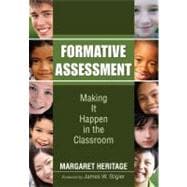
Note: Supplemental materials are not guaranteed with Rental or Used book purchases.
Purchase Benefits
What is included with this book?
| Foreword | p. ix |
| Acknowledgments | p. xi |
| About the Author | p. xiii |
| About the Contributor | p. xv |
| Introduction | p. 1 |
| Bridging Theory, Research, and Practice | p. 1 |
| Overview of the Chapters | p. 2 |
| Changes in Practice | p. 4 |
| Assessment With and for Students | p. 7 |
| The Process of Formative Assessment | p. 10 |
| Determine Learning Goals and Define Criteria for Success | p. 10 |
| Elicit Evidence of Learning | p. 11 |
| Interpreting the Evidence | p. 12 |
| Identifying the Gap | p. 12 |
| Feedback | p. 13 |
| Adapting and Responding to Learning Needs | p. 14 |
| Scaffolding New Learning | p. 14 |
| Close the Gap | p. 14 |
| Classroom Culture | p. 15 |
| Theory Into Practice | p. 15 |
| Formative and Summative Assessment | p. 18 |
| Summing Up | p. 19 |
| Reflection Questions | p. 20 |
| It All Depends on What the Data Tell You | p. 21 |
| The Big Assessment Picture | p. 22 |
| Appropriateness for Purpose | p. 23 |
| Making Sense of the Data | p. 24 |
| Different Assessments for Different Purposes | p. 26 |
| Different Grain Sizes | p. 26 |
| Taking Action | p. 28 |
| Where Does Formative Assessment Fit In? | p. 28 |
| Putting It All Together | p. 30 |
| Summing Up | p. 36 |
| Reflection Questions | p. 36 |
| The Drivers of Formative Assessment: Learning Goals and Success Criteria | p. 37 |
| Learning Progressions | p. 38 |
| Developing a Learning Progression for Reading | p. 40 |
| Developing a Learning Progression for Mathematics | p. 42 |
| Learning Goals and Success Criteria | p. 44 |
| Identifying Learning Goals and Success Criteria | p. 45 |
| Revising Learning Goals and Success Criteria | p. 51 |
| Communicating Learning Goals and Success Criteria to Students | p. 53 |
| Summing Up | p. 55 |
| Reflection Questions | p. 55 |
| Formative Feedback for Teaching | p. 57 |
| Generating the Evidence | p. 57 |
| Quality Feedback for Teaching | p. 58 |
| Revisiting the Teachers | p. 59 |
| Curriculum-Embedded Assessment | p. 70 |
| Technology Tools | p. 71 |
| Helper Practices for Formative Assessment | p. 71 |
| Planning Instruction and Assessment | p. 72 |
| Who Is Assessed and When? | p. 73 |
| Interpreting Evidence | p. 74 |
| The "Just Right Gap" | p. 74 |
| Differentiating Instruction | p. 75 |
| Building a Repertoire | p. 76 |
| Summing Up | p. 78 |
| Reflection Questions | p. 78 |
| Formative Feedback for Learning | p. 79 |
| Teacher Feedback | p. 80 |
| Types of Teacher Feedback | p. 81 |
| Timing of Feedback | p. 83 |
| Feedback as Instructional Scaffolding | p. 84 |
| Feedback and Self-Regulation | p. 84 |
| Examples of Teacher Feedback | p. 84 |
| Using the Feedback | p. 90 |
| What About Grades? | p. 90 |
| Student Feedback | p. 91 |
| Peer Feedback | p. 91 |
| Feedback From Self-Assessment | p. 93 |
| Summing Up | p. 97 |
| Reflection Questions | p. 97 |
| Implementing Formative Assessment: What Do Teachers Need to Know and Be Able to Do? | p. 99 |
| Creating the Classroom Culture | p. 99 |
| Classroom Management | p. 101 |
| Teacher Knowledge | p. 101 |
| Content Knowledge | p. 103 |
| Knowledge About Metacognition | p. 105 |
| Pedagogical Content Knowledge | p. 105 |
| Students' Previous Learning | p. 107 |
| Assessment Knowledge | p. 108 |
| Teacher Skills | p. 110 |
| Interpreting Evidence | p. 111 |
| Providing Feedback | p. 112 |
| Matching Instruction to the Gap | p. 113 |
| Teaching Peer Assessment | p. 114 |
| Teacher Attitudes | p. 115 |
| Summing Up | p. 116 |
| Reflection Questions | p. 116 |
| Developing and Deepening Formative Assessment Practice | p. 117 |
| A Daunting Prospect? | p. 117 |
| A Professional Culture for Change | p. 118 |
| Professional Development to Support Teachers' Use of Formative Assessment | p. 119 |
| Planning for PLCs | p. 120 |
| The Content of the PLCs | p. 123 |
| The Role of School Administrators | p. 127 |
| Summing Up | p. 131 |
| Reflection Questions for Teachers | p. 131 |
| Reflection Questions for Administrators | p. 131 |
| References | p. 133 |
| Index | p. 139 |
| Table of Contents provided by Ingram. All Rights Reserved. |
The New copy of this book will include any supplemental materials advertised. Please check the title of the book to determine if it should include any access cards, study guides, lab manuals, CDs, etc.
The Used, Rental and eBook copies of this book are not guaranteed to include any supplemental materials. Typically, only the book itself is included. This is true even if the title states it includes any access cards, study guides, lab manuals, CDs, etc.